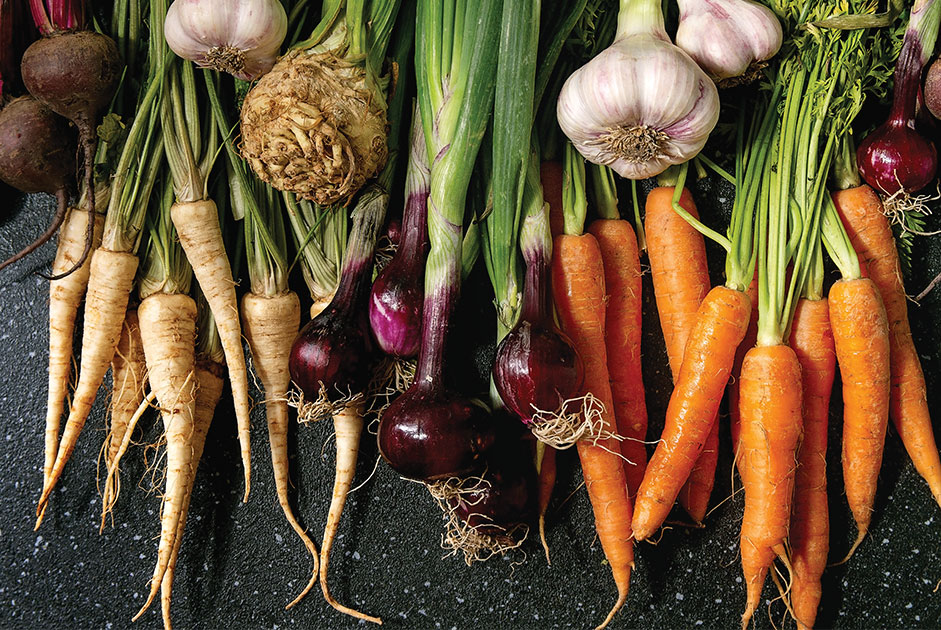In one day, you’ll receive a 10-pound sack of potatoes, bunches of onions graciously offered from a neighbor, and a handful of carrots and beets from visiting relatives. Undaunted by the high quantity of root vegetables, it may bring to mind a long list of hearty stews, casserole dishes and homemade soups. We may not consider how the long list of rooted vegetables aids a healthy diet, with a distinct set of nutrients and health benefits; therefore, ensure each vegetable is properly preserved!
Beets
In addition to lowering blood pressure levels and improving heart health, eating beets elevates athletic performances and increases blood flow to the brain! Besides, it’s great for slowing the growth and spread of cancerous cells.
All root vegetables will last one to three months without washing or cutting. If the room is not available in the refrigerator crisper drawer, pack beets in a small cooler with sawdust!
Carrots
As snacks are eaten raw or cooked, carrots are the second most nutritious vegetables. Linked to lowering cholesterol levels and cancers while improving vision, lovers of the orange vegetable can thank the impressive list of vitamins and antioxidants.
Wilting occurs when carrots lack hydration that comes from the greens; therefore, remove the tops. Similar to separating potatoes from onions, keep carrots far from apples and pears. For the duration of three to four months, store in a cold location within a box of dry leaves or sawdust; otherwise, the refrigerator will keep carrots crisp for up to a month.
Onions
High in fiber, vitamin C and rich in antioxidants, the compounds found in onions significantly reduce blood sugar levels and offer powerful anticancer properties and prevent disease!
Distance the storage of onions from all other vegetables. Consider containing onions in a basket or mesh produce bag. The goal for longevity is to maintain a dark environment while allowing the flow of cool air.
Sweet Potatoes
Rich in fiber, vitamins A and C, manganese and antioxidants, such as beta-carotene, chlorogenic acid and anthocyanins; the result of consumption includes improving immune function, vision, blood sugar levels and supports skin health.
As tubers can attract insects and mold, allow freshly dug sweet potatoes and yams to dry to draw out excess moisture in a warm location; then, wrap each one in newspaper and store in a cool pantry receiving consistent temperatures between 55 and 60 degrees.
Potatoes
The versatile starch contains fiber, vitamins B6, C and potassium and manganese, yet did you know it’s a resistant starch, which means the potato will ferment in and increase protection against chronic digestive diseases? Eating potatoes is an anti-inflammatory and has antioxidant properties, too!
While sweet potatoes are similar in storage, do not store if potatoes are white. A crate with open slats works best in an area that’s dry and dark, such as a basement or garage. Ideal temperatures are between 35 and 40 degrees. Wrap each one in cloth or place spread out on layers of newspaper. Make sure the newspaper covers the slides to eliminate light. Keep an eye on your long-term root vegetables. It’s true; one can spoil the bunch!
Turnips
Boosting immunity, shortening respiratory infections and cancers, the solution is consuming cruciferous vegetables, such as turnips, cauliflower, cabbage, kale, broccoli and other green leafy vegetables. A source of vitamins C, E and K, and minerals, such as folate, plant-based compounds help lower inflammation, while fiber aids in weight loss.
Be selective in choosing vegetables for long-term storage. Slightly bruised will likely not endure the expected four-to-five-month timeframe. It’s also vital to not wash beforehand; instead, allow to dry. Like other vegetables, turnips need a cold, moist place, ranging from 35 to 40 degrees. If room allows, wrap each one in a paper towel and keep in the refrigerator’s crisper drawer.
Non-Basement Options
Never fear! There are numerous alternative options to store root crops. Consider a crawlspace, garage, mudroom or even under the back porch. The goal is to ensure the vegetables do not experience deep freezes. If possible, create a root cellar by digging a semi-deep hole below the frost line. Use a rodent-proof container, such as a large cooler or crate, surround the vegetables with peat moss or sand, and cover the hole with sturdy plywood.
Obtaining vegetables is rarely a challenge; you too can preserve the bulk of the harvest to endure you through a potentially long winter!





















